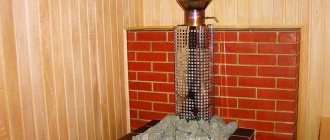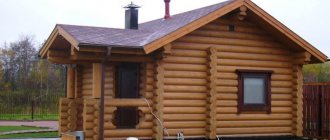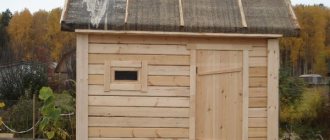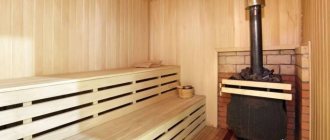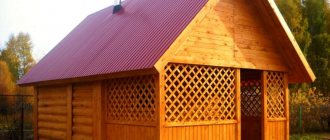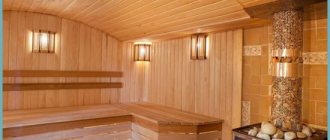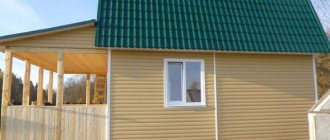A lot has been said about the Russian bathhouse, such fabulous descriptions have been given that it even becomes strange: it turns out that the bathhouses were larger than the village huts. Recently, the sauna, which is often called the Finnish bath, has become popular in Russia. What other types and varieties of baths exist, how do they differ? We understand the types of baths according to different classifications .
- What is a bathhouse: not every bathhouse is a bathhouse
- Types of Russian baths
- Types of baths according to different criteria
- Methods of heating baths - types of baths according to heating method
- Features of the microclimate - types of baths according to the difference in microclimate
- Bathhouse construction material - types of bathhouses based on wall material
- Types of baths among different nations
The question is specifically posed in this way, since, having found one analogy, we often transfer it to other analogues. As a result, it turns out that the characteristic property of one is transferred to the other, but is not its characteristic property. This is how Finnish baths, Russian saunas, Turkish baths, Japanese baths and so on appear. What they have in common is the ability to wash rather than steam, but even this is very conditional.
Japanese bath
Let's start the review of baths with the most exotic and especially different from its “brothers” in the design and procedures of the bath - the so-called Ofuro. In terms of its usefulness and relaxing properties, it surpasses the Japanese
Ofuro is very difficult, since during this procedure there is no significant overheating of the body, and the water and atmosphere are filled with the aromas of herbs, beneficial plants and relaxing oils. Doctors and traditional healers have long known the fact that the most actively beneficial components of plants are absorbed through the skin.
Japanese Ofuro is a wooden container, on the bottom of which useful herbs, flowers, sawdust, etc. are laid out. A person is immersed in this container, up to his neck in water soaked in herbs. From below, the water is heated to a temperature of 55 degrees. Stay in heated water for no more than 20 minutes. Such bathing is useful for frequent colds, arthritis, and increased fatigue. You don't have to go to Japan to enjoy hot water bathing. This service is quite successfully offered in modern spas.
Makeup artist Maria Usacheva
Steam bath
– one of the most ancient and effective methods of deep skin cleansing. The moist steam softens the top layer of skin and makes it easier to remove, leaving skin smooth and fresh. The heat increases blood circulation and activates the pores and glands, which draw dirt and toxins to the surface of the skin.
Steam baths get rid of acne and congestion, rejuvenate the skin, smooth out wrinkles, and the face becomes fresher and smoother. Steam baths for dry or aging skin are done once every two weeks, as frequent steam baths dry out the skin. For oily, normal or combination skin – once a week.
A steam bath can be done in two ways. I find it most convenient to use a “Chamomile” type inhaler.
.
To prepare a steam bath in this way, boil a glass of clean water, add to the water a tablespoon of a mixture of herbs suitable for your skin type, this will be discussed below. Cover and let sit for two minutes. Pour the resulting decoction into a special container of the inhaler, add 3-5 drops of essential oil. Then you do everything as with regular inhalation - assemble the inhaler, plug it in and place your face in a special cup, as in the picture.
If you do not have such an inhaler, you can use a regular saucepan
.
For a liter of boiling water, add 4 tablespoons of a mixture of herbs suitable for your skin type. Cover the pan, turn off the stove and leave for two minutes. Remove the lid, add 10 drops of essential oil. Keep your face 30-45 cm from the surface of the water, cover your head and pan with a thick blanket to create a steam bath. 5-10 minutes will be enough.
Never press anything on your face
after the procedure! Mechanical cleaning is carried out by cosmetologists; it is not recommended to do this at home. Instead, you can use a gelatin mask to remove blackheads (an article about this coming soon).
After the steam bath
(masks) wipe your face with an ice cube to close the pores, blot with a paper napkin and lubricate with cosmetic oil. You can use a rich cream, but I prefer oil, as the combination of steam bath and oil rejuvenates and moisturizes the skin.
Components of a steam bath for different skin types.
For any skin type, add bay leaf
and
licorice
. Bay leaf improves blood circulation, licorice removes toxins. Other herbs soften the skin and have a healing effect. Essential oils add aroma and relax.
For normal
skin: thyme, chamomile, fennel, essential oils of lavender, geranium or bergamot.
For dry
skin: marshmallow, chamomile, orange zest, neroli or chamomile essential oils.
For oily
skin: lemon balm, fennel, essential oils of juniper and lemon.
For the fading
skin: cinnamon, cloves, eucalyptus, nettle, rosemary essential oil.
For problematic
skin: burdock root, yarrow, black currant leaf, essential oils of lemon, bergamot, cedar.
If you have very dry, sensitive or redness-prone
skin
with prominent veins, you may be better off using a gentler cleansing option.
Makeup artist Maria Usacheva
Steam baths get rid of acne and congestion, rejuvenate the skin, smooth out wrinkles, and the face becomes fresher and smoother.
Turkish bath - Hammam
Their structure is very reminiscent of Roman baths with the number of rooms with a gradually increasing temperature, luxury in the interior, fountains, natural marble finishing, etc. You can spend an infinite amount of time in steam rooms, since the temperatures here are not particularly exhausting, even the steam here is cold and damp (compared to a Russian or Finnish bathhouse).
However, the usefulness of such a bath is obvious, since gradual warming up of the body is the best cure for many diseases. Traditionally, a hammam is a place for relaxation, many pools, steam rooms, rooms for relaxation, tea drinking and communication.
Method of heating and steam generation
To bring the bathhouse to the specified temperature and humidity conditions, two main methods are used.
- Direct heating - closed, open or combined heater stoves are installed directly in the steam room, although some solid fuel models can be heated from an adjacent room. Steam is generated by the stone mass, to which water is periodically supplied.
- Distributed heat - pipes are built into the walls, floors and sun loungers, through which heated water circulates, heating the surfaces. In the original version, steam from water boiling in the boiler circulated through pipes laid in the floor, and it was supplied to the steam room through holes in the walls. In the modern version, the coolant is heated by an electric or gas boiler, and the humidity is provided by a specialized steam generator.
In both the first and second options, as it heats up, not only the equipment, but also the walls become a heat source, and additional heating occurs due to convection. To provide heat to the washing room, modern baths often have a water-heated floor.
American Bath – Temescal
The inventors of this method of washing were the Mayan Indian tribes, from whom the tradition was passed on to other tribes (for example, the Aztecs). Temescal is a small hut, in the center of which there was a pit with heated stones (later small stone ovens began to be built in this place).
The stones were watered, 2-3 people in the hut were steamed using herbal brooms, and after the procedure they were washed with cold water. In large cities, bathhouses were also multi-room, there were both steam rooms and swimming pools. To this day, such baths continue to exist in traditional villages in Mexico.
Building a hammam yourself
- The room must have a ventilation hood. To prevent moisture from entering the general ventilation system, an air dehumidifier should be installed in front of it. The ventilation valve must be open at all times.
- The sewerage system must be equipped with a drain with an odor-blocking device.
- A modern Turkish sauna is heated using a special steam generator.
- To heat the floor, walls and seats, water or electric heating is installed. It is better to choose a water one, as it is more profitable to use and from an economic point of view. It consists of small-diameter pipes laid in three independent circuits (for seats, floors, walls) with hot water moving through them.
- The room must be well insulated and waterproofed. The total pie of the walls together with insulation is approximately 7-15 cm. The pie includes mineral wool 5-10 cm thick, heat-reflecting insulation, a waterproofing layer, a heating system, plaster or cement screed for leveling the walls. Marble, ceramic tiles, mosaics made of marble, glass or ceramics are used as cladding.
- The operating temperature must be above 30°C. Heated surfaces must be turned on 6-8 hours before the procedure. The heating temperature should be set to 45°C. The steam generator is started 1-2 hours before the procedure.
- You should purchase a steam generator that will fit the parameters of the room. It has a built-in temperature sensor that turns it off if the room temperature becomes higher than the set temperature. The steam generator is also equipped with an automatic flushing system. The device is connected to centralized water supply and electricity. In private residential buildings it is connected to a separate circuit. This is done so as not to turn on the heating of the entire house during the warm season.
- For wiring, use only cables that can withstand high temperatures. For lighting, it is allowed to use only those lamps that are protected from moisture.
In Russia, the most common are steam generators produced by Tylo (Sweden), Helo (Finland), Harvia (Finland).
Conclusion
Russian bath
Every Russian person has at least a rough idea of how a Russian bathhouse works, but not everyone knows what a Russian bathhouse looked like in its traditional form.
Classic Russian version
Previously, three main types of baths were common. The first type is a black bath. It was an ordinary hut with a stove, which was built without a chimney, was heated by releasing smoke through the doors and windows, then they washed and steamed in it. This method of heating a bathhouse was considered the most useful, since soot and soot protected against microbes. The second type is a white bath. It differed from the black one only in that the stove had a pipe that exhausted the smoke in a way that was already familiar to us. The third type is “vlaznya”. The bathhouse itself was not used here as a separate room. A Russian stove was heated in a residential building, the contents of the stove were emptied, the walls were cleaned of soot, a man crawled inside with a vat of water and washed himself right inside the stove.
Features of the Finnish sauna
Although there is an opinion that the Finns themselves are not at all opposed to giving in to the parka and waving a broom, the saunas that have spread throughout the world with their light hand are dry-air saunas. The humidity in them is minimal, the temperatures are extreme, and people steam mainly while sitting. The air warms up evenly and there is no such difference between the temperature on the bottom shelf and on the top, as in a Russian bath. Due to the sitting position, steam rooms are characterized by compact dimensions and a compact metal stove with an open heater. And since it is not necessary to pour water over the stones to create steam in saunas, the stoves can also be electric, which do not need to be heated, just set the appropriate mode. Saunas are often not separate buildings, but rooms directly in the house, since minimal humidity does not create any special problems when arranging a wall “pie”.
Whether in a bathhouse or a sauna, the effect depends not only on the microclimate in the steam room, but also on the “extras”.
p9181848FORUMHOUSE Member
The most important detail of a proper bath: a barrel, a font, or better yet, a pool, albeit a small one, for example, 150x200 cm, with a depth of 100 cm. After all, it is the consistent change in temperature when immersed in cold water that gives the main healing effect of the bath: temporary vigor; real euphoria (release of internal endorphins and serotonin); resulting long-term boost in immunity.
Stages of interior finishing
Finishing the steam room in the bathhouse is the final stage of construction. After covering the walls, all that remains is to secure the electrical wiring. It is carried out in stages.
- Finishing begins from the ceiling . A sheathing of wooden slats 25 cm thick is fixed on top of the vapor barrier. The clapboard is hemmed to them from below. The direction is chosen based on the size of the steam room. Laying usually starts from the wall with the doorway or from the window.
- Before you start covering the walls, choose a laying method. The lining is attached perpendicular to the sheathing elements.
- Slats 25 mm thick are fixed to the walls. The lining is assembled using the tongue and groove method. Fixed with clamps or nails to the sheathing.
- Cover the joints between the ceiling and walls with skirting boards. The same thing is done with the joints between the floor and walls.
- If the steam room has a floor on joists, no additional finishing is needed. If the floor is concrete, wooden gratings assembled from planks with a distance of 5 cm from each other are placed between the shelves.
After installation, the lining can be painted or varnished or treated with wax.
A log bathhouse does not need clapboard cladding.
Finishing materials
Do-it-yourself interior decoration of a bathhouse begins with the choice of material. It is small - just a tree. However, you need to choose wood that accumulates heat, but itself heats up moderately. Because of this, you cannot use boards or lining made of coniferous wood . When heated, the resin releases and becomes very hot.
The following breeds are recommended for the steam room :
- linden - does not heat up, is not afraid of steam and water, smells wonderful and is very beautiful;
- aspen is not so attractive, but it only becomes harder from the action of water and steam;
- alder – does not heat up and is affordable;
- oak is an elite finishing for a steam room with excellent qualities, but very expensive.
Of the coniferous species, it is allowed to use larch and cedar , since this wood is less resinous. In addition, cedar wood is rich in beneficial essential oils.
The form of finishing is lining or tongue and groove boards. The first option is more convenient, since it is easier to join the lining. The panels are impractical.
What materials cannot be used
Only solid wood is suitable for finishing a bath.
All other building materials for finishing a steam room are not suitable for various reasons:
- wood materials, like MDF, chipboard - do not withstand such strong changes in temperature and moisture, quickly swell and deform;
- plastic panels of any kind cannot withstand such high temperatures, especially when it comes to a sauna;
- tiles - they heat up too much, there is a risk of burns, but it is permissible to use tiles for flooring;
- stone cladding – it takes too long to heat up and takes a long time to cool down; this option is suitable for a hammam, but not for a steam room.
Any modification of these materials is prohibited.
